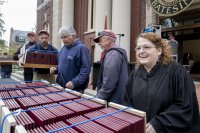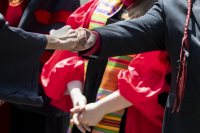
It takes a campus to raise a Commencement
For graduating seniors, Commencement is a magical time. After four years of all-night study sessions, harrowing exams, and lengthy theses, walking across a stage and shaking President Clayton Spencer’s hand seem to be the easiest part of getting a diploma from Bates.
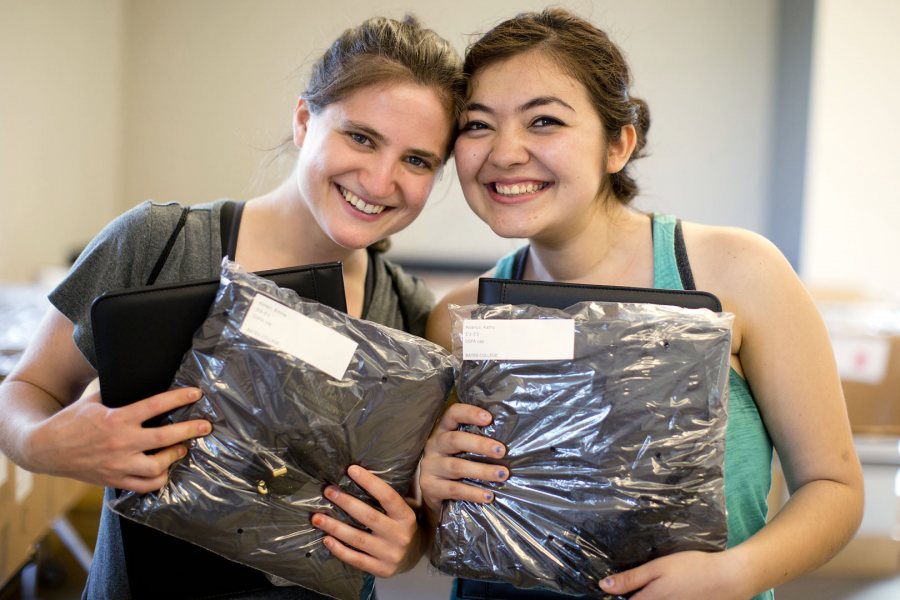
Passing another marker on the road to Sunday’s Commencement, seniors and close friends Emma Korein (left), a psychology and French major from Rydal, Pa., and Kathy Polanco, an environmental studies and theater major from Los Angeles, pose for a portrait as they pick up their caps and gowns in Commons on May 27. (Phyllis Graber Jensen/Bates College)
Yet seniors are able to float through Commencement, taking place May 31 this year, only because of the extensive work and planning that take place in nearly every corner of the Bates community.
“It’s almost harder to find an office that doesn’t have anything to do with Commencement,” says Mary Meserve, college registrar.
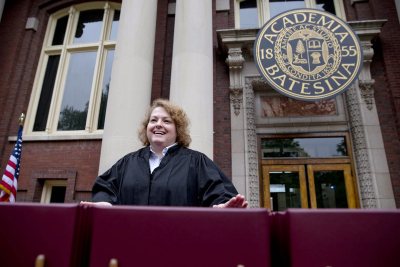
On the Coram Library porch, Registrar Mary Meserve checks the diplomas one last time just prior to Commencement 2014. (Phyllis Graber Jensen/Bates College)
From Facility Services and Dining Services to the offices of the president and the dean of the faculty, the people behind the scenes — an estimated 180 to 200 — have the production of Commencement down to an art.
In chronological order, here’s a sampling of the hundreds of actions, both tiny and Historic Quad-sized, that add up to a thrilling Commencement:
During the prior year: The president’s office contacts potential honorary degree recipients, who can be nominated by any member of the campus community and who are selected by the trustee Committee on Honorary Degrees.
August: The registrar’s office sends students the first reminder to check whether they’re on track to finish their academic requirements.
February–March: Claire Schmoll, executive assistant to President Spencer, orders the academic regalia for the honorary degree recipients.
After the snow melts (late April): Bill Bergevin, landscape architect, starts readying the grounds for Commencement. This year’s lingering winter, Bergevin says, “shortened the time frame” for campus beautification. During Short Term 2015, Bergevin has overseen a grounds crew of nine students, most of them seniors.
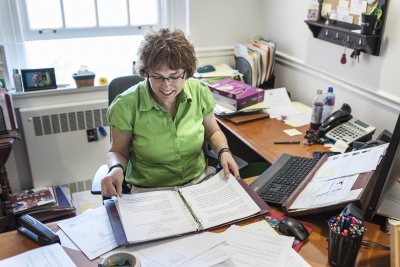
Claire Schmoll, executive assistant to President Spencer, prepares the formularies — compilations of all the Commencement speeches for use on stage — in her Lane Hall office. (Josh Kuckens/Bates College)
Late April: The dean of the faculty’s office starts encouraging seniors to call and leave voicemails in which they pronounce their names slowly and correctly, twice.
Dean of the Faculty Matthew Auer, who calls the students’ names at Commencement, estimates that three-quarters of seniors do leave a message.
Late April–May: Registrar Mary Meserve repeatedly checks the spelling and other details on the seniors’ diplomas, which were ordered from a North Carolina company in March. In the last two weeks of May, the diplomas are alphabetized, sorted into wooden racks, and checked again.
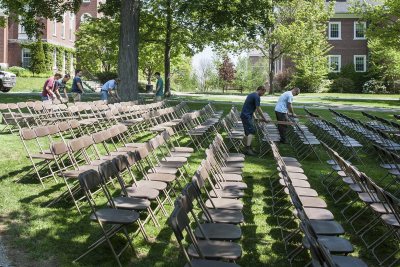
Facility Services workers use boards to set the proper distance between rows of Commencement 2015 seating. (Josh Kuckens/Bates College)
Early May: Christine Schwartz, assistant vice president for dining, conferences, and campus events, holds a Commencement logistics meeting with 42 representatives from departments across campus.
This year’s heated controversy: should bottles of water be available in barrels of ice at the ceremony, which may not be photogenic, or under the seats as in years past, where they are often wasted? (Answer: Barrels of water will be available.)
Monday afternoon, three weeks before Commencement: The Commencement choir, composed of primarily underclassmen, meets with John Corrie, lecturer in music and Bates College Choir director, for their first practice.
This year, the song selected is “For Good” from the musical Wicked. (As in past years, Portland Brass, bagpiper Rob Simmons, and the Atlantic Clarion Steel Band will also perform.)
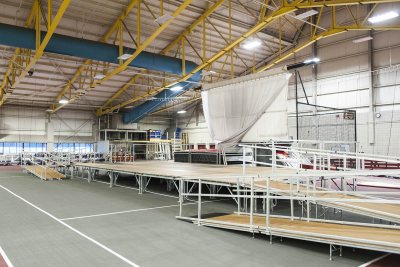
The fallback stage: In case of inclement weather, a second Commencement stage is set up in Merrill Gymnasium. (Josh Kuckens/Bates College)
Last two weeks of May: President Spencer meets with Communications Office staffers for a final review of the honorary-degree citations, which have been researched and written in a collaborative process. Around a table, they read the citations line by line, ensuring that the texts are powerful on paper and in voice.
In addition, Schmoll collates two binders — one for Dean Auer and one for President Spencer — that contain all of the speeches in the Commencement program and will be placed on their podiums on the morning of the ceremony.
Week before Commencement: This being Maine, Facility Services constructs two stages for the event: one on the Coram Library porch facing the Historic Quad and another inside Merrill Gym as a rain site.
The rental companies supplying chairs, audio and video equipment, etc., do not fully equip both sites, but it makes sense to build two stages because that’s the most time-consuming task.
On the Quad, Facility crews set out bleachers and about 2,500 folding chairs, using 3-foot boards to set the spacing between rows of chairs.
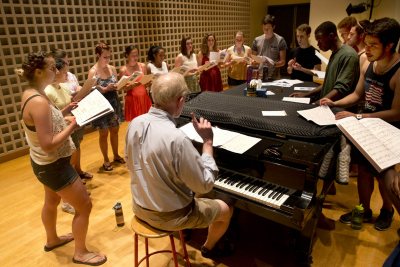
John Corrie rehearses the Commencement choir on the stage of the Olin Arts Concert Hall on May 27. They will sing “For Good” from the musical “Wicked.” (Phyllis Graber Jensen/Bates College)
Wednesday before Commencement: In Commons, the custodial staff begins to hand out the graduation robes — an estimated 487 of them — that were ordered in January.
Virginia Sturgis, custodial supervisor, calls the process “very personal,” as many of the custodians are able to give gowns to students that they have known all year.
Meanwhile, Schwartz, Schmoll, and Assistant Dean of the Faculty Kerry O’Brien meet at 8 a.m. for the initial weather call to decide which Commencement site to make ready, though Schwartz waits as long as she can to make a final call.
Noon Friday before Commencement: The registrar’s office officially closes. The list of graduating seniors is finalized and distributed shortly after. Receiving the names enables the Communications Office to finish editing and designing the program, and it is sent to Penmor, a local printer, for printing and delivery by noon Saturday.
Commencement eve: A Dining Services staff of 100 works overnight to prepare the lunch served after Commencement. Schwartz estimates that they serve 5,000 to 6,000 people every year with upwards of 3,200 lobster rolls, 1,200 chicken salad sandwiches and 800 servings of a vegetarian option.
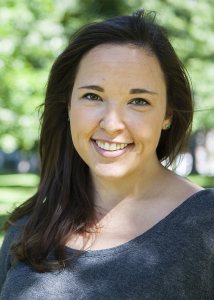
Story author Becca Carifio ’15 earned honors in history for her thesis “Wonder Woman Revealed: William Moulton Marston, World War II and the Rise of a Superheroine (1941-1959).” (Sarah Crosby/Bates College)
2:30 a.m. Commencement Day: In the midst of preparing the Commencement luncheon for later that day, Dining Services provides a late-night breakfast for hordes of seniors pulling the traditional all-nighter before graduation.
7:30 a.m. Commencement Day: Facility Services staff arrives at the registrar’s office to move the 13 to 15 racks of diplomas to the stage, where they are checked again to ensure that the diploma that each student receives walking across the stage is in fact their own.
9:20 a.m. Commencement Day: In the final run-up to the ceremony, O’Brien lines up the faculty on Alumni Walk for the procession, as do Associate Dean of Students James Reese with the seniors and Schmoll with the platform party (the president, honorands and company).
At 9:20, Schwartz texts Sturgis, stationed in Hathorn Hall, with the order to flip the switch that rings the bell for the first toll cuing the processional. And Commencement begins.
Preparation for Commencement never stops. Schwartz knows the dates of Commencement through 2021 and is always fine-tuning the planning process.
Graduates remember Commencement as an once-in-a-lifetime memory — but for the rest of the Bates community, it is a job polished to perfection through years of practice.
